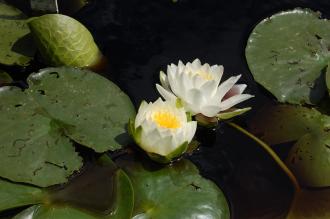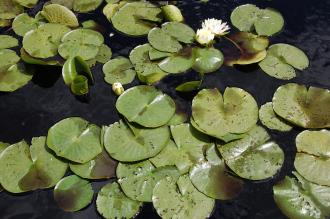
Nymphaea odorata Flower (30/06/2012, Kew Gardens, London)
Position: Full sun to partial shade
Flowering period: Summer
Soil: Wet (planting depth 30cm -1.8m)
Eventual Height:10cm (above water)
Eventual Spread: 5m
Hardiness: 6a – 10b
Family: Nymphaeaceae
Nymphaea odorata is a deciduous, aquatic, perennial plant. Its dark green leaves are round with a ‘V’ notch, smooth with a waxy coating, up to 25cm across and float. The underside of the leaf is red/ purple. Its leaves are attached to rhizomes by underwater stalks. Its fragrant white flowers have yellow stamen, numerous white petals with pointed tips, are up to 15cm across, rise on solitary stalks and float. They open in the day time and close again in the evening and once pollinated they are pulled below water level for maturation. Its fruit is an ovoid capsule, is up to 2cm across and contains many seeds. Its roots are branched rhizomes which aid the spread of this plant.
Nymphaea odorata commonly known as the Fragrant Water Lilly, American White Waterlilly or Beaver Root, is native to eastern North America. In its native habitat it is found in shallow lakes, ponds and slow moving water and typically forms monospecific stands. Compounds of this plant have a history of medicinal use. It is considered to be an invasive weed on the west coast of America.

Nymphaea odorata (30/06/2012, Kew Gardens, London)
The etymological root of the binomial name Nymphaea is derived from Greek mythology where nymphs were minor deities associated with specific locations, including springs or small bodies of water. Odorata is from the Latin meaning ‘fragrant’, referring to the fragrance of the flowers.
The landscape architect may find Nymphaea odorata useful as an aquatic plant in lakes and ponds. Care should be taken when specifying this plant as it will require an amount of management if it is not to dominate the habitat.
Ecologically, N. odorata is attractive to pollinating insects. Its seeds are attractive to wildfowl and mammals.
N. odorata prefers wet soils, with a planting depth in water of 30cm to 1.8m. It tolerates most pH of soil.
Nymphaea odorata may require maintenance in the form of the removal of self seeded and spreading plants.

